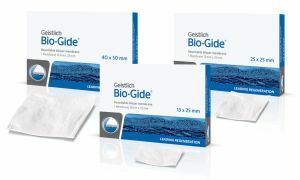 Geistlich Bio-Gide( Bio Hyde) is a resorbable two-layer membrane for tissue repair. It is obtained from collagen type 1 and 3 from pigs, which are characterized by high purity and biocompatibility. It is from such a fibrillar protein that the connective tissue and the skin of a person basically consist. Such a biomembrane performs its protective function well.
Geistlich Bio-Gide( Bio Hyde) is a resorbable two-layer membrane for tissue repair. It is obtained from collagen type 1 and 3 from pigs, which are characterized by high purity and biocompatibility. It is from such a fibrillar protein that the connective tissue and the skin of a person basically consist. Such a biomembrane performs its protective function well.
Spongiosa Bio-Oss( Bio-Oss) is a natural osteoplastic substitute made from bovine bones, from which almost all organic compounds have been removed. It is distinguished by good survival and tolerability.
Thanks to the appearance of these two unique materials, the possibilities of modern dentistry have expanded.
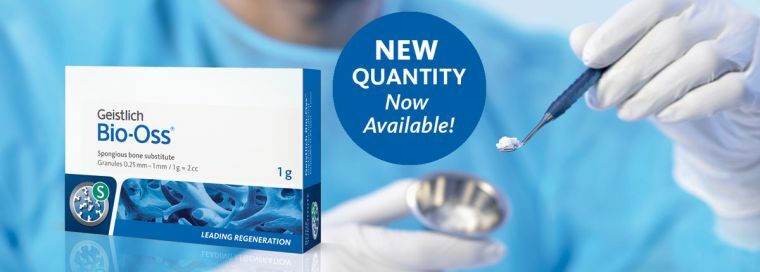
Contents
- Biomaterial characteristics
- Scope
- Restrictions on the use of
- Application features
Biomaterial characteristics
Basic characteristics of the Bio-Gide membrane:
- The membrane consists of 2 layers: porous and dense. It is placed in such a way that the porous surface is directed towards the bone tissue, so that its cells grow into the membrane, and the dense surface contacts the soft tissues in order to prevent their germination to the pathological focus.
- The material is hypoallergenic and has good biocompatibility. In experiments on animals, it was found that the
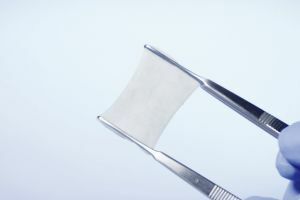 membrane completely resolves. Its decay occurs with the participation of enzymes. At the same time, acids that irritate tissues are not formed, as is the case with synthetic membranes containing polylactides.
membrane completely resolves. Its decay occurs with the participation of enzymes. At the same time, acids that irritate tissues are not formed, as is the case with synthetic membranes containing polylactides. - Thanks to the three-dimensional structure of fibers, the biomaterial promotes the rapid healing of damaged tissues. And the membrane retains its structure even in the wetted state. It can be fixed with the help of seams or pins, while the fibrillar protein swells to form a universal basic tissue structure, so that the engraftment to the bone tissue occurs quickly. Despite the fact that usually inflammation does not occur, but taking into account the characteristics of the biomaterial, it should not be ruled out.
Unique features of collagen material Bio-Oss:
- In the production of biomaterial organic compounds are removed, only the inorganic matrix remains. It consists of micropores and capillaries located between apatite crystals. The structure of the biomaterial is similar to the structure of apatite molecules of healthy bone tissue, so it is faster connected to the bone than other osteosubstitution natural materials consisting of larger crystals.
- Because of the porous structure, the inner surface of Bioassum is at least five times greater than existing bone-substituting
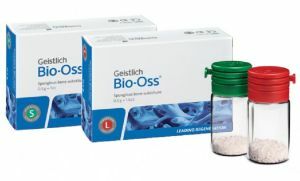 preparations, as a result, osteoblasts and blood vessels germinate faster and the material gets better.
preparations, as a result, osteoblasts and blood vessels germinate faster and the material gets better. - Due to the rough surface of the material, bone cells adhere to it better and multiply faster.
- Biomaterial dissolves slowly, so it is a stable base for the emerging new bone and prevents premature destruction of the graft. The implant is integrated into the human bone tissue for several years.
- Due to the peculiarities of its structure, Bioass takes part in bone tissue remodeling processes in the body, while artificial materials used for osteoplasty decompose as a result of chemical transformations.
Scope of Application
Indications for use of Bio-Oss and Bio-Gide materials:
- filling of bone defects around implants and wells after surgical dental treatment, including after cyst removal and root amputation;
- augmentation of the alveolar ridge for the appointment of orthopedic therapy and implant placement;
- holding a sine-lifting.
The Bio-Hyd membrane is used for surgical treatment of injured mucous membranes of the mouth.
Both materials can be used together.
Restrictions on the use of
Contraindications to the use of Bio-Gide:
- can not be used alone to restore bone tissue, but only in combination with any filler;
- is not used if an active inflammatory process is observed( it should be treated before the biomaterial is installed);
In order to eliminate defects in the periodontal region, before introducing the biomaterial Bio-Oss, it is necessary to sanitize the oral cavity, remove plaque and stone, and cure dental diseases.
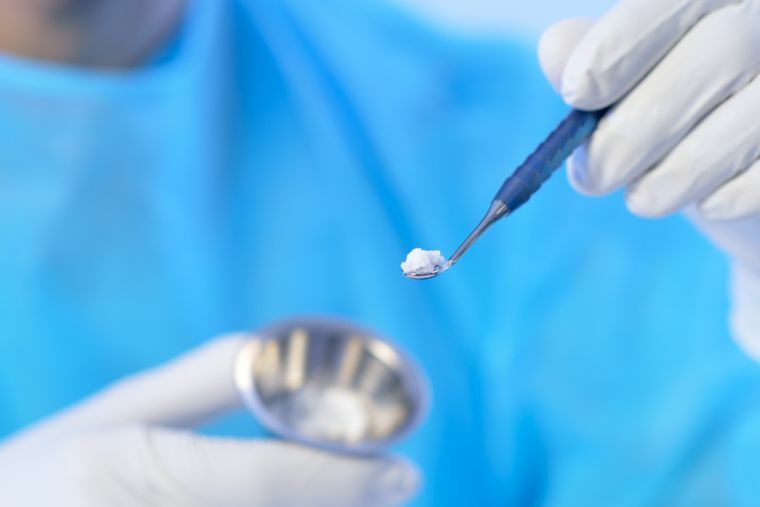
Bone biomaterial can be used in sinus lifting
Contraindications to the use of Bio-Oss:
- acute and chronic purulent-necrotic process in the bone at the place of dental manipulation;
- metabolic disorders, including diabetes, softening of the bones, fibrocystic ostitis;
- osteoporosis;
- marked renal and hepatic insufficiency;
- reception of glucocorticosteroids in high doses.
Bio-Gide and Bio-Oss should not be used in women in the position and breast-feeding.
Application features
Bone-Oss bone material can be used alone and in combination with the natural bone tissue of the patient.
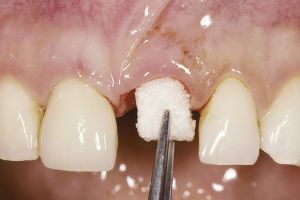
Restoration of bone tissue after tooth extraction
Bio-Oss material is placed in the bone defect and covered with Bio-Gide biomembrane, which does not give fast-growing connective tissue to prevent bone tissue regeneration that occurs more slowly. This prevents the loss of bone replacement material and increases the chance of implant engraftment.
When manipulating the oral mucosa, the Bio Hyde membrane is used alone to heal the damaged area. It is not necessary to extract it, since it completely resolves after 2 months. Its application gives a good aesthetic result in the surgical treatment of soft tissues.
Usually, when applying materials Bio-Gide and Bio-Oss there are no undesirable reactions, but given their composition, do not exclude the development of allergies.
